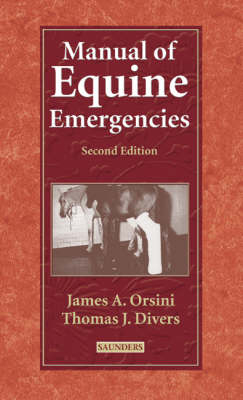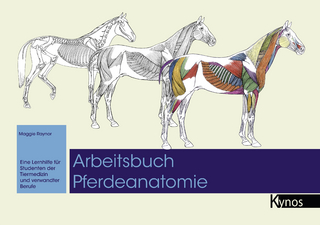
Manual of Equine Emergencies
W B Saunders Co Ltd (Verlag)
978-0-7216-9298-2 (ISBN)
- Titel ist leider vergriffen;
keine Neuauflage - Artikel merken
Designed for ease of use in the clinical setting, this up-to-date resource provides all of the essential information needed on equine emergency medicine and surgery. Medical and surgical principles and procedures for all organs and body systems are presented in an easy-to-use format. Laboratory tests are described and include details on how to obtain the best samples and interpret test results. Authored by experts in the field, this one-of-a-kind manual presents data on principles and procedures, organ system examination, neonatology, shock and temperature related problems, interpretation of lab tests, pharmacology and toxicology, and management of special problems.
James A. Orsini is an Associate Professor of Surgery at the University of Pennsylvania and has been a faculty member for more than 35 years. Dr. Orsini teaches in multiple disciplines, including both basic and clinical courses throughout the professional curriculum. He has co-edited four editions of Equine Emergencies - an Elsevier book and one of the health sciences' best-selling equine publications. In addition, he has authored several hundred papers, book chapters, abstracts and proceedings. Dr. Divers is a diplomate of both the American College of Veterinary Internal Medicine and American College of Veterinary Emergency and Critical Care. His equine interest are in any medical diseases of the horse and research projects have centered around neurologic and liver diseases of horses, critical care medicine, in addition to several infectious diseases.
PART ONE: Emergency Medical and Surgical Principles and Procedures Section I: General Diagnostic and Therapeutic Procedures 1.Blood Collection 2.Medication Administration 3.Intravenous Catheter Placement 4.Intraosseous Infusion Technique 5.Regional Perfusion 6.Bacterial, Fungal, and Viral Infection Diagnoses 7.Biopsy Techniques 8.Endoscopy Techniques 9.Ultrasound Examination Section II: Respiratory System 10.Nasotracheal and Orotracheal Tube Placement 11.Transtracheal Aspiration and Bronchoalveolar Lavage 12.Nasal Oxygen Insufflation 13.Assisted Ventilation 14.Tracheotomy 15.Paranasal Sinus Trephination 16.Thoracocentesis and Chest Tube Placement Section III: Gastrointestinal System 17.Aging Guidelines/Dentistry 18.Nasogastric Tube Placement 19.Abdominocentesis and Peritoneal Fluid Analysis 20.Cecal Trocharization 21.Esophagostomy Section IV: Genitourinary System 22.Urinary Tract Catheterization Section V: Musculoskeletal System 23.Local Anesthesia for the Diagnosis of the Lameness 24.Arthrocentesis and Synovial Fluid Analysis 25.Temporomandibular Arthrocentesis 26.Endoscopy of the Navicular Bursa Section VI: The Eye 27.Corneal Scraping 28.Fluorescein Staining 29.Nasolacrimal Duct Cannulation 30.Nerve Blocks/eye 31.Subpalpebral Catheter Placement Section VII: Central Nervous System 32.Cerebrospinal Fluid Collection 33.Caudal Epidural Catheterization PART TWO: Organ System Examination, Neonatology, Shock, and Temperature-Related Problems Section I: Organ System Examination 34.Cardiovascular System 35.Gastrointestinal Emergencies and Other Causes of Colic 36.Integumentary System 37.Liver Failure; Hemolytic Anemia 38.Blood Coagulation Disorders 39.Musculoskeletal System 40.Nervous System 41.Ophthalmology 42.Reproductive System 43.Respiratory System 44.Urinary System Section II: Neonatology 45.High-Risk Pregnancy 46.Neonatology 47.Foal-Cardiopulmonary Section III: Shock and Temperature-Related Problems 48.Shock and Systemic Inflammatory Response Syndrome 49.Temperature-Related Problems PART THREE: Laboratory Tests 50.Emergency Measurements of CBC, Serum, Chemistries, Blood Gas, and Body Fluid in Equine Practice 51.Cytology PART FOUR: Pharmacology and Toxicology 52.Pharmacology and Adverse Drug Reactions 53.Toxicology PART FIVE: Management of Special Problems 54.Disaster Medicine 55.Management of Acute Pain 56.Anesthesia for Field Emergencies and Euthanasia 57.Nutritional Guidelines for the Injured Horse 58.Emergency Diseases Seen in Europe Emergency Drug Dosages Appendix I: Reference Values Appendix II: Worming Schedule Appendix III: Immunization Schedules Appendix IV: Product Manufacturers Appendix V: Breed Chart Appendix VI: Long Bone Physeal Fusion Times Appendix VII: Trade/Generic Names Used in Equine Practice Appendix VIII: Susceptibility Patterns of Organisms Isolated from Equine Submissions Appendix IX: Resources for the Veterinarian for Information on Terrorist Attacks and Emergency Preparedness
| Erscheint lt. Verlag | 18.12.2002 |
|---|---|
| Zusatzinfo | Over 245 ills |
| Verlagsort | London |
| Sprache | englisch |
| Maße | 127 x 210 mm |
| Gewicht | 110 g |
| Themenwelt | Veterinärmedizin ► Pferd |
| ISBN-10 | 0-7216-9298-2 / 0721692982 |
| ISBN-13 | 978-0-7216-9298-2 / 9780721692982 |
| Zustand | Neuware |
| Haben Sie eine Frage zum Produkt? |
aus dem Bereich


